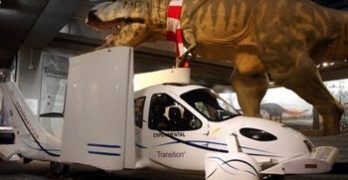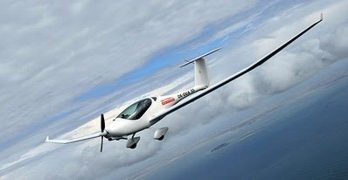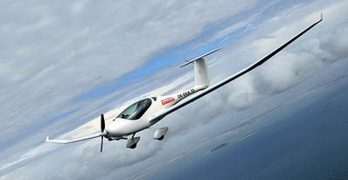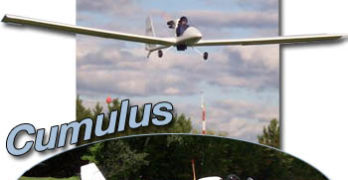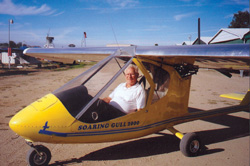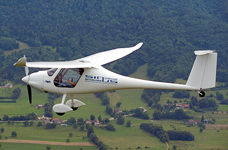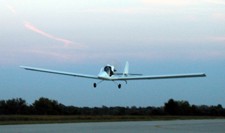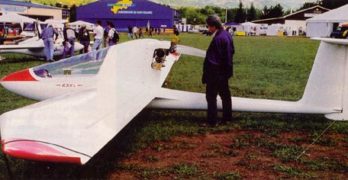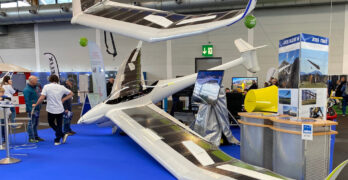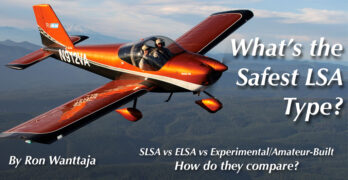After taking a few days off to boat around Lake George, NY and shoot the Red Bull Air Race in New York City, it’s time to catch up on what’s been happening. *** The Transition “Roadable Aircraft” (I can’t help but prefer the chummier “flying car”) just got a weight exemption nod from FAA for an additional 110 pounds of MTOW (max takeoff weight). That nudges the vehicle up to 1,430 pounds. *** Terrafugia‘s request for the bump is meant to provide “…the structure and equipment necessary for compliance with the Federal Motor Vehicle Safety Standards (FMVSS) which are not found in other Light Sport Aircraft.” *** They’re talking about things such as airbags, energy absorbing crumple zone and protective safety cage. *** Interestingly, Transition’s maker Terrafugia initially asked for an MTOW of 1,474 pounds. FAA in effect said “You can have what we gave the amphib makers, but no more.” *** This evokes the ultralight days, when the original 150 lb.
Search Results for : motorglider
Not finding exactly what you expected? Try our advanced search option.
Select a manufacturer to go straight to all our content about that manufacturer.
Select an aircraft model to go straight to all our content about that model.
Phoenix Motorglider To Debut at Sun ‘n Fun 2010?
Last year, I almost got to do a flight report on one of the most enjoyable airplanes I’ve ever flown: an Urban Air Lambada SLSA motorglider. *** Alas, before the magazine could schedule the story, two (not one, but two) Lambadas broke up in flight, both in very strong soaring conditions. *** The design was immediately suspect of course, though plenty of load tests on the Czech Republic design both before and after the incidents had failed to show any structural weakness. *** Both pilots used their onboard ballistic parachutes by the way, which saved both their lives. That’s yet another strong argument right there for onboard parachute systems: no way would they have survived otherwise. *** One breakup was evidently a case of pilot overspeeding – way overspeeding, and during 1500 fpm soaring conditions to boot. Yikes. The other is still under investigation but pilot error is suspect there too.
Phoenix Motorglider To Debut at Sun ‘n Fun 2010?
Last year, I almost got to do a flight report on one of the most enjoyable airplanes I’ve ever flown: an Urban Air Lambada SLSA motorglider. *** Alas, before the magazine could schedule the story, two (not one, but two) Lambadas broke up in flight, both in very strong soaring conditions. *** The design was immediately suspect of course, though plenty of load tests on the Czech Republic design both before and after the incidents had failed to show any structural weakness. *** Both pilots used their onboard ballistic parachutes by the way, which saved both their lives. That’s yet another strong argument right there for onboard parachute systems: no way would they have survived otherwise. *** One breakup was evidently a case of pilot overspeeding – way overspeeding, and during 1500 fpm soaring conditions to boot. Yikes. The other is still under investigation but pilot error is suspect there too.
Remember the Cumulus Motorglider? It’s Flying!
In the 1990s I tried my hand at developing an airplane. While that business venture didn’t make me a millionaire, it provided a valuable lesson about what it takes to stay in the light-sport airplane business. Later, I realized the project needed someone who understood building techniques better than I did. That man was Dave Ekstrom and he ultimately took over my design, the Cumulus, a motorglider. He calls his business Ultralight Soaring Aviation LLC .
In the world of soaring, a motorglider is an expensive flying machine, making it not so different than high-end LSA that cost $130,000 or more. But Ekstrom comes from the world of homebuilts and he knew he could produce a kit for a lot less if buyers were willing to pull a few rivets (about 300 total hours are needed).
One of the 21 Cumulus builders is Andre Girard of Ottawa, Canada, who kindly provided Dave with the photos you see (five Cumulus kits are now airborne).
Earthstar Soaring Gull 2000; Light Motorglider
An old friend just brought home an airplane I’ve long admired. Bob Chase of California’s Perris Valley airport is the proud new owner of Soaring Gull 2000 No. 1 from Earthstar Aircraft designer Mark Beierle. Though its wingspan is only 28 feet (think: easy storage), Soaring Gull 2000 manages a 16:1 glide that will assure you can stay aloft on most days with decent thermal or ridge lift. The Gull 2000 single seater fuselage is fitted with a wing two bays (~ 2 ft.) longer than Earthstar’s two seat Odyssey. Because the airplane is small and efficient, the 133 square foot wing has plenty of area; she is said to soar quite well. My favorite old Cloud Dancer had 16:1 performance (on 40-ft. wings of the same area); I managed two hours engine off for every powered hour. I loved soaring it and I look forward to accepting Bob’s offer to fly his.
Sinus LSA-type Motorglider Soars Magnificently
One aircraft I’d waited anxiously to fly is the Sinus from Pipistrel in Slovenia. Forget the weird-sounding name (they say to pronounce it “seen-us”) because this is one impressive flying machine. I first saw it in France four years ago and my pilot report will appear in the October 2005 issue of Ultralight FLYING!. You’ll want to read that article for lots more info but the operative performance parameter is a 28-to-1 glide! I had the good fortune to fly a tricycle-gear Sinus for 45 minutes with the engine off, as it’s designed to do. Wonderful! For more info on Sinus and their other oddly named Virus aircraft, click here.
New Cumulus Ultralight Motorglider
After a six-year wait the New Cumulus Ultralight Motorglider took to the air thanks to Ultralight Soaring Aviation owner Dave Ekstrom. The original Cumulus required some redesign work that Ekstrom and team accomplished and tested. Now, orders are building and shipments have started. Previous kit owners are getting changed materials that should allow them to get airborne and new owners are starting work on kits. Email Dave at: ekstrom@midwest.net
Ultralight Motorgliders
The ultralight motorglider evolution continues in Europe.
Ultralight motorgliders are as rare as hen’s teeth in the U.S., but Europe is blessed with several choices that nicely complement high-end, high-priced full-size motorgliders. While America has the lovely Esprit from Aero Dovron, our soaring friends across the Atlantic continue to lead this specialized market.
Full-size (higher-weight) motorgliders start at more than $100,000 and can surpass $200,000. Those who can afford them are surely thrilled with such beautiful machines, but most of us can’t spend that kind of money regardless of their superb performance.
However, at $20-$30,000 ready-to-fly, a clean self-launching soaring aircraft is more affordable. Like their larger siblings, these efficient designs can also cruise under power respectably well, giving them broader appeal than pure gliders.
Noins’ Excel
One of the newest of the breed is the Excel from France’s Noins Aeronautiques Alpaero. Based in beautiful Tallard in the French Alps, Noins is revered by French soaring pilots.
Day 3 at AERO: A Look At Sailplanes & Towplanes
The cavernous halls of the Messe truly do contain the aspirations and, let’s be honest, the dreams of literally dozens of designers. There were quite possibly more new types than I have ever seen, and I’ve been attending the Friedrichshafen show for over 20 years. Anyone who claims general aviation is dying would only need to see this show to have their viewpoint radically altered.
Gliding has always been well represented at AERO, and in the show’s 30th year all the major sailplane manufacturers were out in force. For many years AERO was a biennial event and when the organizers made it an annual show, many decided to stick with the biennial schedule and only attend on even-numbered years. There were many different permutations of self-launching and self-sustaining sailplanes on show, which utilized piston engines, electric motors and small jets.
Jonker JS3
South African company Jonker has several versions of the “engine-on-stick” solution for its JS3 single seat high performance sailplane, including an electric motor turning a two-blade propeller and a small jet.
Light Sport Accidents — How Do The Categories Compare?
Editor’s Note: This two-part short series is the handiwork of Ron Wanttaja, who has been tracking accident and registration data for Experimental aircraft for decades. Here, he looks at both the fleet size and accident rates among the various LSA categories. Looking ahead, the next installment will dig deep into how LSAs fare against more common certified trainers.
It’s been almost 20 years since the FAA implemented the Light Sport Aircraft category. While the planes might appear similar to traditional Experimental/Amateur-Built (E/A-B) aircraft, there are significant differences in how they are designed, constructed, maintained and operated.
Light Sports have had a major impact on flying in the U.S., even if their numbers are still relatively few. Without Light Sport (and the accompanying Sport Pilot program), the FAA would have lacked data to justify the simplification of pilot medicals known as BasicMed. Light Sport’s proven safety led to the MOSAIC program, featuring a major relaxation of the limits of what can be flown without an FAA medical.
- « Previous Page
- 1
- 2
- 3
- 4
- 5
- …
- 23
- Next Page »


